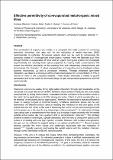Files in this item
Effective permittivity of co-evaporated metal-organic mixed films
Item metadata
| dc.contributor.author | Mischok, Andreas | |
| dc.contributor.author | Hale, N | |
| dc.contributor.author | Gather, Malte Christian | |
| dc.contributor.author | Di Falco, Andrea | |
| dc.date.accessioned | 2021-03-11T15:30:03Z | |
| dc.date.available | 2021-03-11T15:30:03Z | |
| dc.date.issued | 2021-02-28 | |
| dc.identifier | 272664542 | |
| dc.identifier | 9376890e-8309-4aa6-a5a8-f5a62c775c7e | |
| dc.identifier | 000630419200001 | |
| dc.identifier | 85101421533 | |
| dc.identifier.citation | Mischok , A , Hale , N , Gather , M C & Di Falco , A 2021 , ' Effective permittivity of co-evaporated metal-organic mixed films ' , Journal of Applied Physics , vol. 129 , no. 8 , 083101 . https://doi.org/10.1063/5.0038899 | en |
| dc.identifier.issn | 0021-8979 | |
| dc.identifier.other | ORCID: /0000-0002-7338-8785/work/90567262 | |
| dc.identifier.other | ORCID: /0000-0002-4857-5562/work/90567717 | |
| dc.identifier.other | ORCID: /0000-0003-4725-7404/work/90568092 | |
| dc.identifier.uri | https://hdl.handle.net/10023/21616 | |
| dc.description | Funding: A.M. acknowledges funding through an individual fellowship of the Deutsche Forschungsgemeinschaft (No. 404587082). A.D.F. is supported by the European Research Council (ERC) grant AMPHIBIANS (819346). M.C.G. acknowledges funding by the Volkswagen Foundation within project No. 93404 and the ERC via StG ABLASE (640012). | en |
| dc.description.abstract | The combination of organics and metals in a composite film holds promise for combining plasmonic interaction with gain and for the realization of epsilon-near-zero (ENZ) metamaterials. In particular, fluorescent organic dyes can be used to compensate the plasmonic losses of a homogenized metal-organic material. Here, we fabricate such films through thermal co-evaporation of silver and an organic host:guest system and investigate experimentally the resulting linear optical properties for varying metal concentrations. We extract the effective permittivity of the resulting films with ellipsometry measurements and demonstrate the formation of silver nanoparticles and resulting strong localised surface plasmon resonances, up until a percolation threshold. Through enhanced light-matter interaction, we observe a maximum of the photoluminescence for a concentration of 15% involume of metal in the composite material. These results showcase a variety of growth parameters and will be useful for the future design of gain-compensated plasmonics and ENZ metamaterials. | |
| dc.format.extent | 7 | |
| dc.format.extent | 1910442 | |
| dc.language.iso | eng | |
| dc.relation.ispartof | Journal of Applied Physics | en |
| dc.subject | QC Physics | en |
| dc.subject | QD Chemistry | en |
| dc.subject | TK Electrical engineering. Electronics Nuclear engineering | en |
| dc.subject | DAS | en |
| dc.subject | MCC | en |
| dc.subject.lcc | QC | en |
| dc.subject.lcc | QD | en |
| dc.subject.lcc | TK | en |
| dc.title | Effective permittivity of co-evaporated metal-organic mixed films | en |
| dc.type | Journal article | en |
| dc.contributor.sponsor | European Research Council | en |
| dc.contributor.sponsor | BBSRC | en |
| dc.contributor.sponsor | European Research Council | en |
| dc.contributor.institution | University of St Andrews. School of Physics and Astronomy | en |
| dc.contributor.institution | University of St Andrews. Sir James Mackenzie Institute for Early Diagnosis | en |
| dc.contributor.institution | University of St Andrews. Centre for Biophotonics | en |
| dc.contributor.institution | University of St Andrews. Biomedical Sciences Research Complex | en |
| dc.identifier.doi | 10.1063/5.0038899 | |
| dc.description.status | Peer reviewed | en |
| dc.date.embargoedUntil | 2021-02-22 | |
| dc.identifier.grantnumber | 819346 | en |
| dc.identifier.grantnumber | P20473 | en |
| dc.identifier.grantnumber | 640012 | en |
This item appears in the following Collection(s)
Items in the St Andrews Research Repository are protected by copyright, with all rights reserved, unless otherwise indicated.

